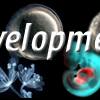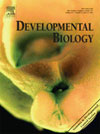





      |
|
Jane Marion Oppenheimer, 1911-1996Jane Marion Oppenheimner, who died on March 19, 1996 at age 84, achieved distinction as an embryologist and historian of science. She was born in Philadelphia on September 19, 1911. After graduating from Bryn Mawr College in 1932 where she majored in zoology, she became a graduate student at Yale University. There she was influenced by John Spangler Nicholas, her Ph.D. advisor, whom she credits with focusing her intellectual interests on both embryology and its history, and by Ross Granville Harrison, director of the Osborn Zoological Laboratories, the leading American embryologist of the day. She received her Ph.D. in Zoology from Yale University in 1935. The work she began as a graduate student formed the basis for her experimental career. Nicholas introduced her to the embryo of the common minnow or killifish, Fundulus heteroclitus, and to a method for dechorionating the embryo he had devised, thus making it possible to perform precise experimental manipulations on teleost embryos. Miss Oppenheimer joined the faculty of Bryn Mawr College in 1938 as an instructor in Biology. She retired from the College faculty in 1980 as the William R. Kenan, Jr. Professor of biology and History of Science. She belonged to numerous professional and scholarly societies. She was president of the American Society of Zoologists (1973) and a fellow of the American Association for the Advancement of Science. Her many honors included election to the American Philosophical Society, of which she was secretary from 1987 to 1992, and the Academy of Arts and Letters. Among her national and international awards were the Otto H. Hafner Award from the American Association of the History of Medicine and Medical Library Association, the Karl Ernst von Baer Medal from the Estonian Academy of Sciences, and the Wilbur Lucius Cross Medal from the Yale Graduate Alumni Association. Bryn Mawr College recognized her teaching with the Christian R. and Mary F. Lindback Award for distinguished teaching in 1976. Miss Oppenheimer was named a "Distinguished Daughter of Pennsylvania" in 1981. Miss Oppenheimer made a number of important contributions to teleost embryology. A group of seven papers published from 1934 to 1937 is especially noteworthy. She showed that induction of a secondary axis including neural structures can and does occur in Fundulus when grafts of vitally stained dorsal lip material from young gastrulae are implanted into hosts of the same stage as the donor. Those grafting experiments demonstrated that the dorsal lip of the fish embryo showed the same organizer as did the dorsal lip of amphibian embryos. Miss Oppenheimer also performed fate mapping experiments of the fish embryo blastoderm and described cell movements of gastrulation. She published a staging series for Fundulus embryos. These early papers provide a wealth of information about the early development of the fish embryo of interest to contemporary workers. Throughout her career as an embryologist, Miss Oppenheimer continued to exploit the methods of experimental embryology to explore questions of induction, differentiation capabilities and regulation. One of her last Fundulus projects involved sending embryos into space to study the effects of zero gravity on embryonic development. She participated in the first joint U.S.-U.S.S.R. cooperative venture: Fundulus embryos were included on the 1975 Apollo-Soyuz space shuttle mission. As an historian of science and medicine, Miss Oppenheimer wrote numerous articles and reviews, many on the origins of embryology. She enjoyed intellectual history and was motivated to write about her library discoveries, believing that "life in our laboratories is made more meaningful to us when we know something about our intellectual forebears." A topic of special interest to her was the relationship of embryological data to evolutionary theory. She also relished telling dramatic stories about early physiological and surgical discoveries. Her biographical work included the great historical figures in embryology, such as Karl E. von Baer, Curt Herbst and Ross Harrison. The influence of her work can be seen in a number of disciplines, including developmental biology and the history of science, anthropology, evolutionary biology and psychology. Miss Oppenheimer's writings will continue to be a source of valuable information and inspiration for others similarly interested in following threads of modern ideas to their historical precedents, especially for more recently educated American scientists whose lack of foreign language training will prevent them from reading original sources. Jane M. Oppenheimer was an exciting scholar whose attention to detail was noteworthy; she was also a prodigious book reviewer with more than 400 published reviews. She respected others who were erudite and had little patience for those who lacked rigor in scholarship. Colleagues who were creative and imaginative as well as rigorous gained her admiration. In recent years, she was delighted by the resurgence of interest in teleost embryology, and she followed modern work on zebrafish development with considerable interest. As much as she appreciated the recognition given her once overlooked Fundulus embryological work done more than a half century ago, she would have been dismayed by the incorrect attributions and bibliographical errors which occur not infrequently in modern journal articles. As an historian and a scientist, she took pains to get all her facts right and to place them in the context of a broader conceptual framework. Borrowing a sentence from one of her own book reviews: "The qualities of her work are inseparable from those of her person." Margaret Hollyday, Department of Biology, Bryn Mawr College, Bryn Mawr, PA 19010-2899
|
 Developmental Biology Published by Elsevier Science under Auspices of Society for Developmental Biology |
|||
|
Page Modified:
|
News | About SDB | Membership | Meetings | Jobs | Education Interactive Fly | Publications | Virtual Library |
© Society for Developmental Biology |